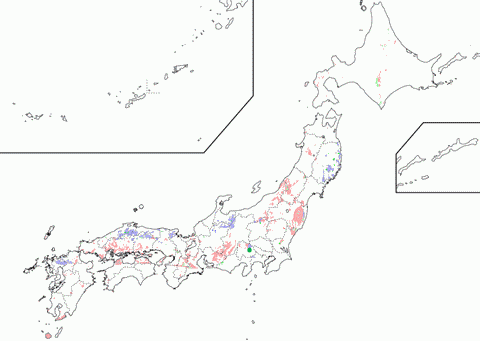Hydrothermal Au-Bi-Te Deposit
Chemical Process (Liquid-phase Growth) - Open system under ground
Synonym
Hypothermal Deposit, Low-T Hydrothermal Vein Deposit, Low-T Hydrothermal Ore Deposit
Index Minerals
Gold, Bismuth, Joséite (Joseite)
Required Geological Setting
Accretionary complexes + Plutonic rocks
Associated metasomatic zones
None
Occurrence
Vein-type deposit formed by 50-100 degree hydrothermal fluid originated from Acidic (I-type Granite) or Neutral (Granodiorite, Diorite) I-type (magnetite-series) magmatic activities. Origin of hydrothermal fluid is magmatic water from magma and/or meteoric water. Meteoric water is circulated by heat of magma. This type of deposits is formed at deep circumstances whereas Hydrothermal Au-Ag deposits are formed at shallow circumstances by the same 50-100 degree hydrothermal fluid. Typical elements concentrated are Au, Bi, and/or Te, and Ag is not concentrated. Host of deposits are basements of plutonic rocks.

Distribution of Low-T Hydrothermal Vein Au-Bi-Te Deposits described in this site. Red is ilmenite-series granite, and blue is magnetite-series granite.
Mineral Assemblages (Ore)
Gold, Sulphur, Bismuth, Joséite (Joseite), Bismuthinite, Pyrite
Mineral Assemblages (Gangue)
Quartz, Calcite
Localities
- Honzawa Mine (Granite)
- Hara Mine (Granite)
- Koshu Mine (Granite)
Related Occurrences
- Pneumatolytic
- Xenothermal
- Hydrothermal (High-T)
- Hydrothermal (Moderately high-T)
- Hydrothermal (Moderate-T)
- Hydrothermal (Moderately low-T)
- Hydrothermal (Low-T)
- Hydrothermal (Au-Ag)
- Hydrothermal (Au-Bi-Te)
- Porphyry type
- Alpine Fissure
- Hydrothermal (Hot Spring)
- Hydrothermal (Fault)